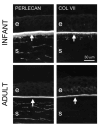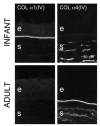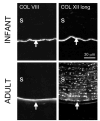Compositional differences between infant and adult human corneal basement membranes
- PMID: 17962449
- PMCID: PMC2151758
- DOI: 10.1167/iovs.07-0654
Compositional differences between infant and adult human corneal basement membranes
Abstract
Purpose: Adult human corneal epithelial basement membrane (EBM) and Descemet's membrane (DM) components exhibit heterogeneous distribution. The purpose of the study was to identify changes of these components during postnatal corneal development.
Methods: Thirty healthy adult corneas and 10 corneas from 12-day- to 3-year-old children were studied by immunofluorescence with antibodies against BM components.
Results: Type IV collagen composition of infant corneal central EBM over Bowman's layer changed from alpha1-alpha2 to alpha3-alpha4 chains after 3 years of life; in the adult, alpha1-alpha2 chains were retained only in the limbal BM. Laminin alpha2 and beta2 chains were present in the adult limbal BM where epithelial stem cells are located. By 3 years of age, beta2 chain appeared in the limbal BM. In all corneas, limbal BM contained laminin gamma3 chain. In the infant DM, type IV collagen alpha1-alpha6 chains, perlecan, nidogen-1, nidogen-2, and netrin-4 were found on both faces, but they remained only on the endothelial face of the adult DM. The stromal face of the infant but not the adult DM was positive for tenascin-C, fibrillin-1, SPARC, and laminin-332. Type VIII collagen shifted from the endothelial face of infant DM to its stromal face in the adult. Matrilin-4 largely disappeared after the age of 3 years.
Conclusions: The distribution of laminin gamma3 chain, nidogen-2, netrin-4, matrilin-2, and matrilin-4 is described in the cornea for the first time. The observed differences between adult and infant corneal BMs may relate to changes in their mechanical strength, corneal cell adhesion and differentiation in the process of postnatal corneal maturation.
Figures







Similar articles
-
Characterization of extracellular matrix components in the limbal epithelial stem cell compartment.Exp Eye Res. 2007 Dec;85(6):845-60. doi: 10.1016/j.exer.2007.08.020. Epub 2007 Sep 2. Exp Eye Res. 2007. PMID: 17927980
-
Comparative analysis of the basement membrane composition of the human limbus epithelium and amniotic membrane epithelium.Cornea. 2012 May;31(5):564-9. doi: 10.1097/ICO.0b013e3182254b78. Cornea. 2012. PMID: 22382594
-
Human corneal basement membrane heterogeneity: topographical differences in the expression of type IV collagen and laminin isoforms.Lab Invest. 1995 Apr;72(4):461-73. Lab Invest. 1995. PMID: 7723285
-
The Corneal Basement Membranes and Stromal Fibrosis.Invest Ophthalmol Vis Sci. 2018 Aug 1;59(10):4044-4053. doi: 10.1167/iovs.18-24428. Invest Ophthalmol Vis Sci. 2018. PMID: 30098200 Free PMC article. Review.
-
Corneal epithelial basement membrane: Structure, function and regeneration.Exp Eye Res. 2020 May;194:108002. doi: 10.1016/j.exer.2020.108002. Epub 2020 Mar 13. Exp Eye Res. 2020. PMID: 32179076 Free PMC article. Review.
Cited by
-
Ocular features in Alport syndrome: pathogenesis and clinical significance.Clin J Am Soc Nephrol. 2015 Apr 7;10(4):703-9. doi: 10.2215/CJN.10581014. Epub 2015 Feb 3. Clin J Am Soc Nephrol. 2015. PMID: 25649157 Free PMC article. Review.
-
Basement membranes in the cornea and other organs that commonly develop fibrosis.Cell Tissue Res. 2018 Dec;374(3):439-453. doi: 10.1007/s00441-018-2934-7. Epub 2018 Oct 3. Cell Tissue Res. 2018. PMID: 30284084 Free PMC article. Review.
-
Extracellular matrix determinants and the regulation of cancer cell invasion stratagems.J Microsc. 2013 Sep;251(3):250-60. doi: 10.1111/jmi.12064. J Microsc. 2013. PMID: 23924043 Free PMC article. Review.
-
Substrate Stiffness Modulates Stemness and Differentiation of Rabbit Corneal Endothelium Through the Paxillin-YAP Pathway.Invest Ophthalmol Vis Sci. 2024 Mar 5;65(3):15. doi: 10.1167/iovs.65.3.15. Invest Ophthalmol Vis Sci. 2024. PMID: 38466286 Free PMC article.
-
Association of TCF4 and CLU polymorphisms with Fuchs' endothelial dystrophy and implication of CLU and TGFBI proteins in the disease process.Eur J Hum Genet. 2012 Jun;20(6):632-8. doi: 10.1038/ejhg.2011.248. Epub 2012 Jan 11. Eur J Hum Genet. 2012. PMID: 22234156 Free PMC article.
References
-
- Kalluri R. Basement membranes: structure, assembly and role in tumour angiogenesis. Nat Rev Cancer. 2003;3:422–433. - PubMed
-
- Nguyen NM, Senior RM. Laminin isoforms and lung development: all isoforms are not equal. Dev Biol. 2006;294:271–279. - PubMed
-
- Alvarado J, Murphy C, Juster R. Age-related changes in the basement membrane of the human corneal epithelium. Invest Ophthalmol Vis Sci. 1983;24:1015–1028. - PubMed
-
- Murphy C, Alvarado J, Juster R. Prenatal and postnatal growth of the human Descemet's membrane. Invest Ophthalmol Vis Sci. 1984;25:1402–1415. - PubMed
Publication types
MeSH terms
Substances
Grants and funding
LinkOut - more resources
Full Text Sources
Other Literature Sources
Miscellaneous

